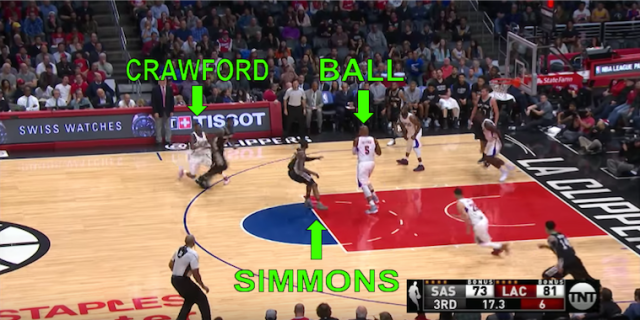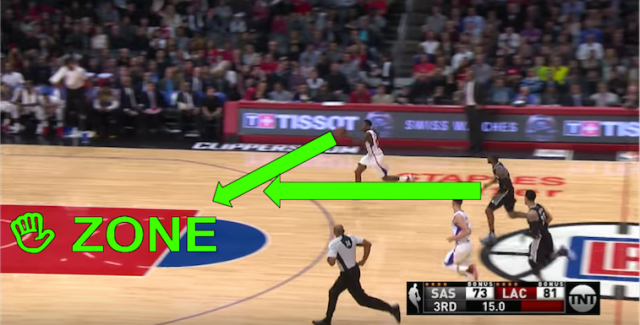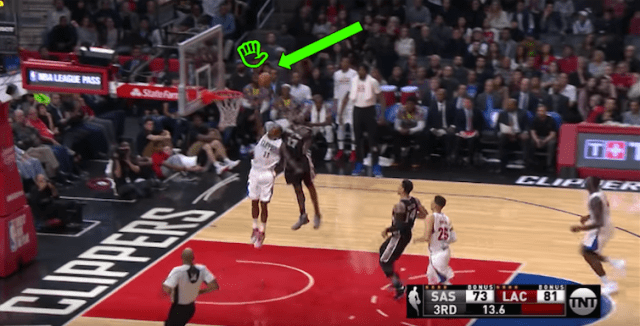It starts with a mistake.
If turning the ball over is a cardinal sin, then the ensuing chase down block is like being absolved by the pope.
For only averaging less than half a block per game, Jonathon Simmons’ ability to stealthily cover the length of the court and inhale an attempted layup or dunk from the opposition has garnered national media attention.
Granted, Simmons doesn’t have the chase down block resume of LeBron James, but both have the ability to single-handedly shift the environment around them.
Most will point to Simmons’ block on Steph Curry earlier this season as the moment he became a sultan of swats, but it may be the block Simmons laid on the King himself last season that sparked his rim protecting potential.
[protected-iframe id=”9d0e04c0a684a88a063d3159f2c518c1-114320562-81586714″ info=”//streamable.com/e/1i9mk” frameborder=”0″ style=”width: 600px; height: 338px;” scrolling=”no” webkitallowfullscreen=”” mozallowfullscreen=”” allowfullscreen=””]The art behind Simmons’ block on James is how he disguises his athleticism and position to look like a half-hearted attempt at slowing down the 3-on-1 fast break.
Tony Parker shifts into backpedaling too early, allowing the bigger, stronger, and faster James to attack the basket and attempt to draw the foul. With Danny Green focusing on Iman Shumpert, James is poised to get an easy basket and potentially a free throw.
What James doesn’t see as he shifts into attack mode is how Simmons has amped up his three long strides into a quick four step gather to launch himself high enough to where his head nearly hits the rim.
But let’s back track a bit.
Unlike in NBA 2K, you can’t earn the “chase down artist” badge overnight.
Simmons has always been excellent at that.
He displayed it with the Brooklyn Nets during Orlando Pro Summer League in 2015. In case people thought it was a fluke, he did it again a few weeks later as a member of the San Antonio Spurs in Las Vegas, while his new boss, General Manager R.C. Buford, watched from the scorer’s table. But there are two questions we seek the answer to with this post:
- When did he first record a chase down block? And
- When did he perfect it?
As the NBA Development League has grown, the amount of stats, video and news archives has grown tremendously. Unfortunately, a lot of links and game logs are missing even from just several years ago.
What we do know is that on Saturday, Sept. 28, 2013, a 24-year-old Jonathon Simmons took $150 to Concordia University and participated in the now infamous tryout with the Austin Toros, earning his spot with the D-League squad.
Simmons tallied 16 blocks in 44 games for the Toros that season, but it’s unknown how many of those came via the chase down. The closest thing we have to a chase down block is this video of “Jonathan” Simmons pinning Maalik Wayns’ shot against the backboard from under the basket.
That video from March 2014 is the first evidence we have of Simmons the Rim Protector. It’s not until November of the 2014-15 D-League season that we see the beginning of Simmons the Chase Down Artist.
[youtube https://www.youtube.com/watch?v=Q71urNnuxec?ecver=1&w=600&h=338]That somewhat answers our first question.
There are noticeable differences from the way Simmons used to stalk his prey in the D-League to how he now engulfs shot attempts from behind.
In most of the above videos, you notice Simmons has impeccable timing. Every single leap towards the rim occurs right at the restricted area, where his length and brute force combine to record the rejection. The downside is all of those early chase down blocks could easily be accompanied by a foul if the referee wants to nitpick at the amount of contact The Juice creates.
Where Simmons has evolved this season is in how he uses his length to record the block, while using his athleticism to contort his body away from the shooter, committing a minimal amount of contact.
In this play against the Los Angeles Clippers, Simmons turns the ball over right to Marreese Speights. After poking the ball out, Jamal Crawford pushes off Dewayne Dedmon to start the fastbreak, while Simmons is flat footed and waiting for Speights to make his move.
The issue here is Speights throws a long lob pass ahead to Crawford, giving Simmons ample time to recover and prepare to inflict pain. Crawford, now forced to catch the ball off a bounce, has a slim distance separating himself from the defense as Simmons makes a dash to the basket, while Crawford is at an angle.
With the way Crawford catches the ball off the bounce, he’s forced to take a dribble to avoid a traveling violation. As if the angle to the basket wasn’t already in Simmons’ favor, the time it takes Crawford to dribble and gather himself for the layup allows Juice to pounce over Crawford for the swat, while twisting his body away from any contact to avoid the foul.
The chase down block is a last ditch defensive effort, but when executed to perfection, it can be undeniably impactful on the confidence and momentum of both sides.
While Simmons may not be the player LeBron James is, his ability to perform the chase down block consistently masks any deficiencies he has on the floor. The example above of his block on Crawford started with Simmons trying to drive and losing the ball to the defender, allowing him to gamble on the block and amend for getting stripped.
That kind of play follows the motto Simmons used in his route to the NBA. If Plan A doesn’t work out, then “Plan B is to make Plan A work.”
Add The Sports Daily to your Google News Feed!



